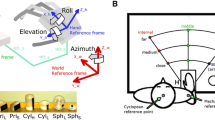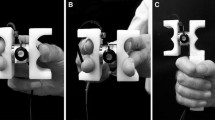Summary
Past studies of the kinematics of human prehension have shown that varying object size affects the maximum opening of the hand, while varying object distance affects the kinematic profile of the reaching limb. These data contributed to the formulation of a theory that the reaching and grasping components of human prehension reflect the output of two independent, though temporally coupled, motor programs (Jeannerod 1984). In the first experiment of the present study, subjects were required to reach out and grasp objects, with or without on-line, visual feedback. Object size and distance were covaried in a within-subjects design, and it was found that both grip formation and reach kinematics were affected by the manipulation of either variable. These data suggest that the control mechanisms underlying transport of the limb and grip formation are affected by similar task constraints. It was also observed that when visual feedback was unavailable after movement onset subjects showed an exaggerated opening of their hands, although grip size continued to be scaled for object size. The question remained as to whether the larger opening of the hand during no-feedback trials reflected the lack of opportunity to fine-tune the opening of the hand on-line, or the adoption of a strategy designed to increase tolerance for initial programming errors. To address this question, a second experiment was carried out in which we manipulated the predictability of visual feedback by presenting feedback and no-feedback trials in a random order. In contrast to the situation in which feedback and no-feedback trials were presented in separate blocks of trials (Exp. 1), in the randomly ordered series of trials presented in Exp. 2, subjects always behaved as if they were reaching without vision, even on trials where visual feedback was continuously available. These findings suggest that subjects adopt different strategies on the basis of the predictability of visual feedback, although there is nothing to suggest that this takes place at a conscious, or voluntary, level. The results of both experiments are consistent with the notion of a hierarchically-organized motor control center, responsible for optimizing performance under a variety of conditions through the coordination of different effector systems and the anticipation of operating constraints.
Similar content being viewed by others
References
Brinkman J, Kuypers HGJM (1973) Cerebral control of contralateral and ipsilateral arm, hand and finger movements in the split-brain rhesus monkey. Brain 96:653–674
Denny-Brown D, Yanagisawa N, Kirk EJ (1975) The localization of hemispheric mechanisms of visually directed reaching and grasping. In: Zulch KJ, Creutzfeldt O, Galbraith GC, (eds) Cerebral localization. Springer, Berlin Heidelberg New York
Elliott D, Allard F (1985) The utilization of visual feedback information during rapid pointing movements. Q J Exp Psychol [A] 37A:407–425
Faugier-Grimaud S, Frenois C, Stein DG (1978) Effects of posterior parietal lesions on visually guided behaviour in monkeys. Neuropsychologia, 16:151–168
Faugier-Grimaud S, Frenois C, Peronnet F (1985) Effects of posterior parietal lesions on visually guided movements in monkeys: Exp Brain Res 59:125–138
Fisk JD, Goodale MA (1990). The effect of instructions to subjects on the programming of visually directed reaching movements. J Mot Behav 21:5–19
Gazzaniga MS, Bogen JE, Sperry RW (1967) Dyspraxia following division of the cerebral commissures. Arch Neurol 16:606–612
Goodale MA (1988) Hemispheric differences in motor control. Behav Brain Res 30:203–214
Goodale MA, Pelisson D, Prablanc C (1986) Large adjustments in visually guided reaching do not depend on vision of the hand or perception of target displacement. Nature 320:748–750
Haaxma R, Kuypers HGJM (1975) Intrahemispheric cortical connexions and visual guidance of hand and finger movements in the rhesus monkey. Brain 98:239–260
Haggard P, Wing AM (1990) Assessing and reporting the accuracy of position measurements made with optical tracking systems. J Mot Behav 22:315–321
Jakobson LS, Archibald YM, Carey DP, Goodale MA (in press) A kinematic analysis of reaching and grasping movements in a patient recovering from optic ataxia. Neuropsychologia (in press)
Jeannerod M (1981) Intersegmental coordination during reaching at natural visual objects. In: Long J, Baddeley A (ed), Attention and performance IX. Hillsdale, Erlbaum pp 153–168
Jeannerod M (1984) The timing of natural prehension movements. J Mot Behav 16:235–254
Jeannerod M (1986) The formation of finger grip during prehension: a cortically mediated visuomotor pattern. Behav Brain Res 19:99–116
Jeannerod M (1988) The neural and behavioural organization of goal-directed movements. Clarendon Press Oxford
Jeannerod M, Biguer B (1982) Visuomotor mechanisms in reaching within extrapersonal space. In: Ingle DJ, Goodale MA, Mansfield RJW (ed), Analysis of visual behavior. The MIT Press, Cambridge, MA pp 387–409
Jeannerod M, Michel F, Prablanc C (1984) The control of hand movements in a case of hemianaesthesia following a parietal lesion. Brain 107:899–920
Kimura D (1986) Neuropsychological test procedures. DK Consultants, London, Ontario
Kirk RE (1982) Experimental design: procedures for the behavioral sciences. Brooks/Cole, Belmont, California
Klapp ST (1975) Feedback versus motor programming in the control of aimed movements. J Exp Psychol 104:147–153
LaMotte RH, Acuna C (1978) Deficits in accuracy of reaching after removal of posterior parietal cortex in monkeys. Brain Research 139:309–326
Lawrence DG, Hopkins DA (1972) Developmental aspects of pyramidal control in the rhesus monkey. Brain Research 40:117–118
Marteniuk RG, MacKenzie CL, Jeannerod M, Athenes S, Dugas C (1987) Constraints on human arm movement trajectories. Canad Psychol 41:365–378
Marteniuk RG, MacKenzie CL (1990) Invariance and variability in human prehension: Implications for theory development. In: Goodale MA (ed), Vision and action: the control of grasping. Ablex Norwood, NJ, pp 49–64
Muir RB (1985) Small hand muscles in precision grip: a corticospinal prerogative? Exp Brain Res [Suppl] 10:155–174
Muir RB, Lemon RN (1983) Corticospinal neurons with a special role in precision grip. Brain Res 261:312–316
Passingham R, Perry H, Wilkinson F (1978) Failure to develop a precision grip in monkeys with unilateral neocortical lesions made in infancy. Brain Res 145:410–414
Perenin M-T, Vighetto A (1983) Optic ataxia: a specific disorder in visuomotor coordination. In: Hein A, Jeannerod M, (ed), Spatially oriented behavior. Springer, Berlin Heidelberg New York, pp 305–326
Perenin M-T, Vighetto A (1988) Optic ataxia: a specific disruption in visuomotor mechanisms. I. Different aspects of the deficit in reaching for objects. Brain 111:643–674
Prablanc C, Echallier JF, Komilis E, Jeannerod M (1979) Optimal response of eye and hand motor systems in pointing at a visual target. I. Spatio-temporal characteristics of eye and hand movements and their relationships when varying the amount of visual information. Biol Cybern 35:113–124
Trevarthen CB (1965) Functional interactions between the cerebral hemispheres in the monkey. In: Ettlinger EG (ed) Functions of the corpus callosum. Ciba Foundation, London, pp 24–40
Volpe BT, Sidtis JJ, Holtzman JD, Wilson DH, Gazzaniga MS (1982) Cortical mechanisms involved in praxis: observations following partial and complete section of the corpus callosum in man. Neurology 32:645–650
Von Hofsten C (1979) Development of visually directed reaching: the approach phase. J Hum Mov Stud 5:160–178
Wallace SA, Weeks DL (1988) Temporal constraints in the control of prehensile movement. J Mot Behav 20:81–105
Wing AM, Turton A, Fraser C (1986) Grasp size and accuracy of approach in reaching. J Mot Behav 18:245–260
Zelaznik HN, Hawkins B, Kisselburgh L (1983) Rapid visual feedback processing in single-aiming movements. J Mot Behav 15:217–236
Author information
Authors and Affiliations
Rights and permissions
About this article
Cite this article
Jakobson, L.S., Goodale, M.A. Factors affecting higher-order movement planning: a kinematic analysis of human prehension. Exp Brain Res 86, 199–208 (1991). https://doi.org/10.1007/BF00231054
Received:
Accepted:
Issue Date:
DOI: https://doi.org/10.1007/BF00231054




